
Features
Training
Back to Basics: September 2013
During training for engine-company operations, instructors teach the importance of advancing the hoseline when a fire attack has been ordered.
September 9, 2013
By Mark van der Feyst
During training for engine-company operations, instructors teach the importance of advancing the hoseline when a fire attack has been ordered. Finesse and efficiency are required to ensure that the hoseline is pulled off the truck quickly, flaked out, and charged. The way the hose is loaded on the hose bed dictates how it will be pulled off the truck.
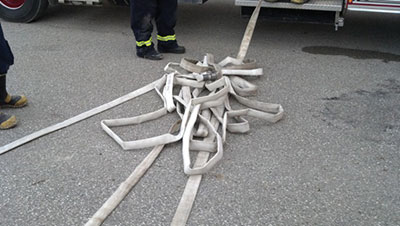 |
|
| Photo 1: When a firefighter advances the hose before unloading the hose bed, the pump operator is often left pulling hose off the truck. The result is generally a pile of tangled hose on the ground beside the truck. |
|
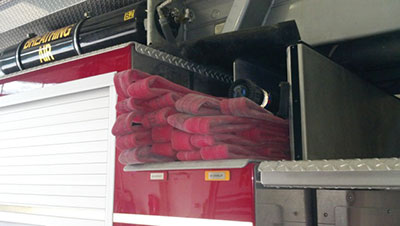 |
|
| Photo 2: The flat load, when it is properly packed, features folds that help the firefighter pull the load off the truck bed. |
|
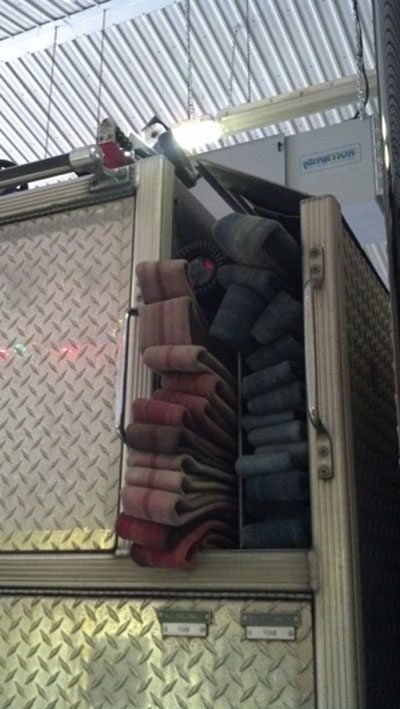 |
|
| Photo 3: The folds produce small loops for firefighters to use to pull the line off the truck. A firefighter can grab three to four loops in one hand to pull a long stretch of hose off of the truck. |
|
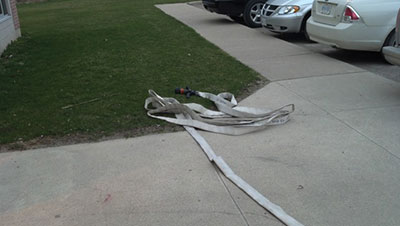 |
|
| Photo 4: Once the firefighter has advanced two handfuls of hoseline, representing 15 to 30 metres (50 to 100 feet) of hose, he can drop the hose beside him, and go back to the truck to unload the rest of the hose bed. |
|
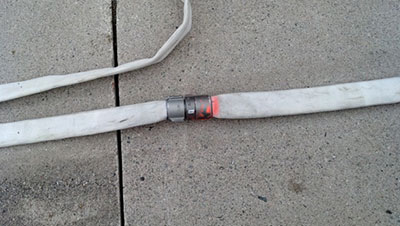 |
|
| Photo 5: With two distinct piles of hose on the ground, the firefighter can grab the nozzle and the middle coupling and walk toward the entrance of the structure. The middle coupling should be marked to make it easily identifiable. |
|
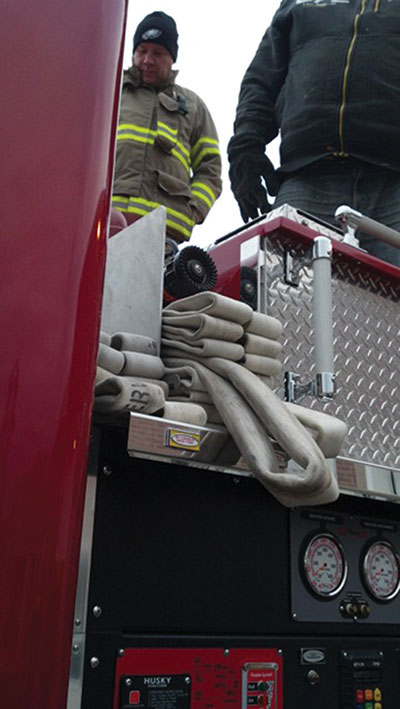 |
|
| Photo 6: The two identified loops of this hoseline represent the halfway point of the load, making it easy for the firefighter to advance a large portion of the hoseline in as little time as possible. |
|
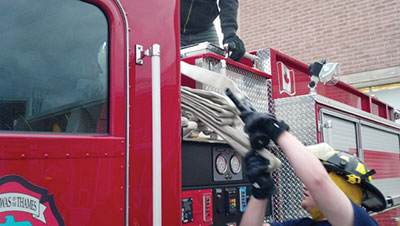 |
|
| Photo 7: When the hose load is pulled off the truck, the advancing firefighter carries about 30 metres (100 feet) of hose in his arms, while the remaining 30 metres of hose is flaked off from the hose bed as he walks away from the truck. photos by Mark van der Feyst
|
One of the more common hose loads is the flat load, which is easy to pull off and to reload. There are variations of the flat load that increase the effectiveness of hose advancement, such as the Minute Man load, which we reviewed in the December 2008 issue of Fire Fighting in Canada. The flat load can be used for both attack lines and supply lines – including one-and-a-half-inch, one-and-three-quarter-inch, two-inch or two-and-a-half-inch.
The one pet peeve that I have when overseeing any kind of engine-company operation drill is when a firefighter pulls the hoseline off the truck by going up to the truck, pulling the nozzle over his or her shoulder, and starting to walk away from the apparatus, thereby pulling the flat load off the hose bed in the same manner as a piece of spaghetti being churned out from a pasta maker. If there are 61 metres (200 feet) of hose on the pre-connect bed, then the firefighter will have to walk a distance of 61 metres to pull the load off of the bed. Usually, the pump operator ends up standing by the load and starts to pull the layers off the hose bed; this creates a pile of spaghetti on the ground by the truck (see photo 1). If the pile is not flaked out correctly and the hose is charged, the hose can become kinked or twist itself into knots, or it can be pushed under the apparatus and be pinched or kinked under the truck’s frame.
Pulling the hose as described above is lazy. Most times, the apparatus is parked close to a building, which limits the space in which to pull off the load. There are better and more efficient ways for one firefighter to pull off the flat load.
A common feature of the flat load is the folds in the hose. You can see in photos 2 and 3 how the folds produce small loops for a firefighter to use to pull the line off of the truck; a firefighter can grab three to four loops in one hand and pull a long stretch of hose off. Using both hands, a firefighter is able to pull off about eight folds of the hoseline at once, or 15 to 30 metres (50 to 100 feet). That bundle of hose can be dropped on the ground next to the firefighter so that they can go back to the hose load and grab the remaining loops to empty the hose off the truck (see photo 4). With two distinct piles of hose on the ground, the firefighter can grab the nozzle and the middle coupling, and walk toward the entrance of the structure.
(For a video demonstration of this technique, click here.)
The middle coupling should be marked to make it easily identifiable. You can see in photo 5 that the middle coupling has been painted orange.
By grabbing the nozzle and the middle coupling, the firefighter is advancing about 30 metres of hose to the front door at one time, which gives the advancing team about 30 metres of hose to bring into the structure.
Another variation of the flat load builds in some handles by identifying two distinct loops with which to pull the load off the truck. As shown in photo 6, the two loops are created at the halfway point in the load. When the load is pulled off, the advancing firefighter carries about 30 metres of hose in his arms, while the remaining 30 metres of hose is flaked off from the hose bed as the firefighter walks away (see photo 7). Once the last 30 metres of the hoseline is completely off the bed, it will become taut because it is attached to the apparatus, forcing the firefighter to let go of the loops and keep advancing the remaining 30 metres of hose.
Once the hose load has been deployed and flaked out, it is important to remove any kinks that may have developed when the line was charged; this needs to be done prior to making entry so that there is no chance of losing water pressure and flow. One hose kink will reduce the water pressure and flow by about 50 per cent; this loss of pressure and flow is detrimental to the life of firefighters. It is critical to maintain constant pressure and flow at all times.
The best way to ensure efficient and effective hose advancement is to practise it. This can be done at any call at which a hoseline is required, during training in any type of weather, or when it’s time to pull the hose off for cleaning or maintenance.
Mark van der Feyst is a 14-year veteran of the fire service. He works for the City of Woodstock Fire Department in Ontario. Mark instructs in Canada, the United States and India and is a local-level suppression instructor for the Pennsylvania State Fire Academy and an instructor for the Justice Institute of B.C. E-mail Mark at Mark@FireStarTraining.com
Print this page